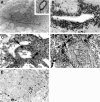Pediatric AIDS-associated lymphocytic interstitial pneumonia and pulmonary arterio-occlusive disease: role of VCAM-1/VLA-4 adhesion pathway and human herpesviruses
- PMID: 10329599
- PMCID: PMC1866586
- DOI: 10.1016/S0002-9440(10)65400-4
Pediatric AIDS-associated lymphocytic interstitial pneumonia and pulmonary arterio-occlusive disease: role of VCAM-1/VLA-4 adhesion pathway and human herpesviruses
Abstract
Because the mechanisms of lymphocyte accumulation in the lungs of children with AIDS-associated lymphocytic interstitial pneumonia (LIP) are unknown, we studied the relative contributions of known adhesion pathways in mediating lymphocyte adherence to endothelium and the potential role of human herpesviruses in the expansion of these lesions. LIP was characterized by lymphoid hyperplasia of the bronchus-associated lymphoid tissue (BALT) and infiltration of the pulmonary interstitium with CD8(+) T lymphocytes. In some individuals there was expansion of the alveolar septae with dense aggregates of B lymphocytes, many containing the Epstein-Barr viral (EBV) genome. Patients with concurrent EBV infection also demonstrated large-vessel arteriopathy characterized by thickening of the intimae with collagen and smooth muscle. Venular endothelium from the lung of children with LIP, but not uninflamed lung from other children with AIDS or lung from children with nonspecific pneumonitis, expressed high levels of vascular cell adhesion molecule-1 (VCAM-1) protein. In turn, inflammatory cells expressing very late activation antigen-4 (VLA-4), the leukocyte ligand for VCAM-1, were the predominant perivascular infiltrate associated with vessels expressing VCAM-1. Expression of other endothelial adhesion molecules, including intracellular adhesion molecule-1 and E-selectin, was not uniformly associated with LIP. Using a tissue adhesion assay combined with immunohistochemistry for VCAM-1, we show that CD8(+) T cell clones that express VLA-4 bind preferentially to pulmonary vessels in sites of LIP: vessels that expressed high levels of VCAM-1. When tissues and cells were pretreated with antibodies to VCAM-1 or VLA-4, respectively, adhesion was inhibited by >/=80%. Thus, infiltration of alveolar septae with CD8(+) T cells was highly correlative with VCAM-1/VLA-4 adhesive interactions, and focal expansion of B cells was coincidental to co-infection with EBV.
Figures



Comment in
-
Findings of misconduct in science.NIH Guide Grants Contracts (Bethesda). 2010 May 14:NOT-OD-10-095. NIH Guide Grants Contracts (Bethesda). 2010. PMID: 20486276 Free PMC article. No abstract available.
-
Note of concern.Am J Pathol. 2010 Oct;177(4):2147. doi: 10.2353/ajpath.2010.100773. Am J Pathol. 2010. PMID: 20884964 Free PMC article. No abstract available.
References
-
- Bye MR, Cairns-Bazarian AM, Ewig JM: Markedly reduced mortality associated with corticosteroid therapy of Pneumocystis carinii pneumonia in children with acquired immune deficiency syndrome. Arch Pediatr Adolesc Med 1995, 148:638-641 - PubMed
-
- Blanche S, Newell ML, Mayaux MJ, Dunn DT, Teglas JP, Rouzioux C, Peckham CS: Morbidity and mortality in European children vertically infected with HIV-1: the French Pediatric HIV Infection Study Group and European Collaborative Study. J Acquir Immune Defic Syndr Hum Retrovirol 1997, 14:442-450 - PubMed
-
- Scott GB, Hutto C, Makuch RW, Mastrucci MT, O’Connor T, Mitchell CD, Trapido EJ, Parks WP: Survival in children with perinatally acquired immunodeficiency virus type 1 infection. N Engl J Med 1989, 321:1791-1796 - PubMed
-
- Marolda J, Pace B, Bonforte RJ, Kotin NM, Rabinowitz J, Kattan M: Pulmonary manifestations of HIV infection in children. Pediatr Pulmonol 1991, 10:231-235 - PubMed
-
- Moran CA, Suster S, Pavlova Z, Mullick FG, Koss MN: The spectrum of pathological changes in the lung in children with the acquired immunodeficiency syndrome: an autopsy study of 36 cases. Hum Pathol 1994, 25:877-882 - PubMed
Publication types
MeSH terms
Substances
Grants and funding
LinkOut - more resources
Full Text Sources
Medical
Research Materials
Miscellaneous

